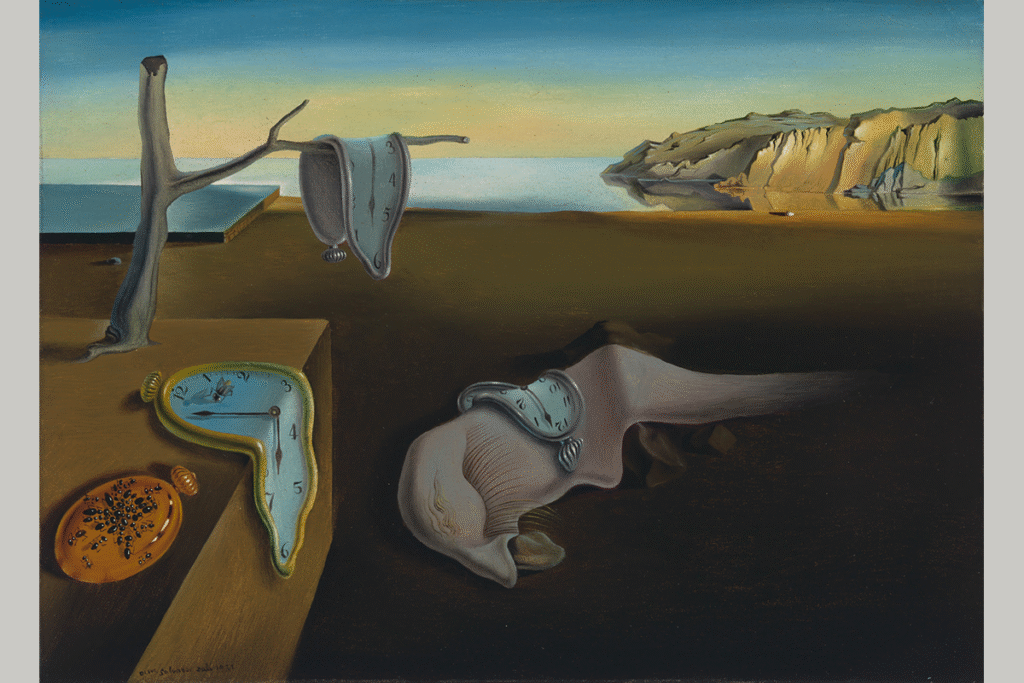Salvador Dalí, The Persistence of Memory, 1931. Museum of Modern Art (MoMA), New York City.
 This visit to the Museum of Modern Art (MoMA) in New York City marked the final official excursion of my college art class before completing our academic year. The number of experiences that we shared will undoubtedly remain etched in our memories. While walking through the galleries, I could not help but think about the time I spent studying in the United States and all the things I have gone through. Nevertheless, on the fifth floor of the Museum, in the surrealistic gallery, there was an artwork that caught my attention. As a matter of fact, it was small, not pretentious, discreet, and if one does not pay attention, this artwork can go unnoticed. This painting is Salvador Dalí’s The Persistence of Memory (1931).
This visit to the Museum of Modern Art (MoMA) in New York City marked the final official excursion of my college art class before completing our academic year. The number of experiences that we shared will undoubtedly remain etched in our memories. While walking through the galleries, I could not help but think about the time I spent studying in the United States and all the things I have gone through. Nevertheless, on the fifth floor of the Museum, in the surrealistic gallery, there was an artwork that caught my attention. As a matter of fact, it was small, not pretentious, discreet, and if one does not pay attention, this artwork can go unnoticed. This painting is Salvador Dalí’s The Persistence of Memory (1931).
At first glance, I was struck by its surreal and dreamlike quality. In this painting, the viewer observes a scene of melting clocks set against a barren landscape. The painting was created using oil on canvas, and it is a quintessential icon of Surrealism. The composition of the painting is striking for its simplicity. However, it is profound in its symbolism. Dalí places three melting clocks on a sort of isolated shore. There is a contrast between the blue sea and the cliffs of the coast of Catalonia in the background. The colors are warm tones in the background. In contrast, the colors used in the foreground are darker.
“Those limp watches… picture ‘the camembert of time’, in Dalí’s phrase. Here, time must lose all meaning. Permanence goes with it: ants, a common theme in Dalí’s work, represent decay, particularly when they attack a gold watch, and they seem grotesquely organic”(1).
Something that I can point out from my art lectures is that Dalí, with his eccentric personality, had a special ability to translate psychological ideas into visual form, reflecting in his works how the human mind works; and The Persistence of Memory is not an exception. This painting is based on Dalí’s Paranoic-critical method, published one year before the painting, where he cultivates “self-induced psychotic hallucinations in order to create art. ‘The difference between a madman and me,’ he said, ‘is that I am not mad.’”(2).
As a legionary brother in formation, I find this artwork to be a tool for evangelization. The theme of memory is significant in Christian tradition. During the consecration, the Catholic priests repeat the words of Christ, “do this in memory of me”, inviting the People of God to remember and participate in the Sacrifice of Jesus. In one of his letters, Saint Paul encourages his beloved friend Timothy to “remember Jesus Christ, raised from the dead, the offspring of David, according to my gospel” (2 Timothy 2, 8). Furthermore, Dalí’s melting clocks can serve as a metaphor for surrendering our human understanding of time to God’s eternal perspective. Moreover, this painting could be used in a prayer setting to meditate on Psalm 90: 4, “For a thousand years in your sight are like a day has just gone by”. In conclusion, this painting helped me as a reminder that the special and non-special moments that pass in our lives may seem fleeting, but they persist in the eternal memory of God, who holds all things in His infinite love.
Foot notes
- G. Lowry, MoMA Highlights, The Museum of Modern Art New York, Belgium 2019, 113.
- MoMA, Salvador Dalí. The Persistence of Memory, 2019, in https://www.moma.org/collection/works/79018, (Referenced on May 5th, 2025).



